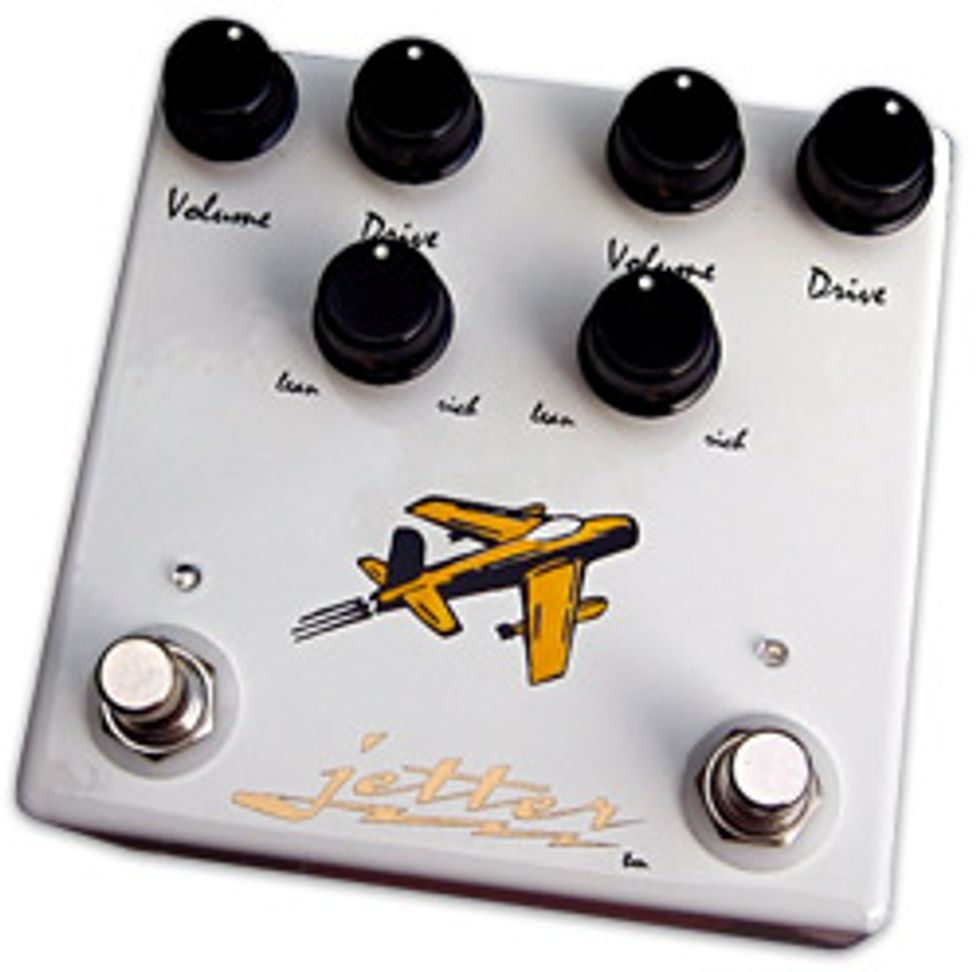The JetDrive mimics the sensitivity of a two-channel boutique amp in an overdrive pedal
 | |
 | |
| Download Example 1 Guitar volume slowly increased | |
| Download Example 2 Set totally clean, single notes. Blue channel - rich then lean. Green channel - rich then lean. | |
| Download Example 3 Both channels engaged, first with the amp set clean, then slightly overdriven. | |
| All clips recorded with a Fernandes S-Type into an Orange Tiny Terror | |
Upon unpacking the Jetdrive, the first surprise was that, though this dual channel overdrive sported switches for each channel, it did not have a master on/off switch. After extolling of the advantages of such a switch on his GS3 model, I was amazed that Jeter had left it off of his new baby. When queried he replied, “I had thought about it, but I would have had to make it the GS3 V2. I really didn't want to do that. Another thing that factored in heavily was a lot of feedback from players that said they didn't have a problem with only two foot switches (many preferred that configuration), and wanted a smaller footprint than the GS3.”
After some consideration I realized that I fell in the second camp myself: a little foot dancing is worth the extra space for another effect on my pedalboard. The Jetdrive lacks the GS3’s battery compartment: you need to take the pedal apart to change the 9-volt, but with the typical long life of the average overdrive battery, this should be an infrequent process. It also supports a standard A/C adapter.
Each channel sports three controls: the Volume and Drive knobs for are pretty standard, but the third knob is not a typical tone. Those are labeled “Lean” on the counterclockwise side and “Rich” on the clockwise end. Jeter says, “These controls have been finely tuned to a specific range of frequencies that are been optimized for maximum impact. The rich/lean controls are very interactive when the channels are cascaded.”
What these ears heard was that the Jetdrive’s “tone” controls tended to affect the midrange. On the “lean” end the mids seemed de-accentuated for a flat tone, not in the sense of unexciting but meaning more or less equal across the frequency spectrum. As the two channels are voiced differently, this leads to different effects, depending on which channel is engaged. Set to the “Blue”—more American sounding—channel (the channels are called Blue and Green for the color of their LEDs, not for any sonic relation to the Jetter Gain Stage Blue or Green pedals), the lean setting served up a beautiful clean boost, ripe for chiming Eric Johnson chords or jazz box standards devoid any boominess. The same extreme lean setting for the British voiced Green allowed that channel’s inherent low mid-range to peek through. Moving either channel’s tone control toward “rich” starts to add more upper mids until about three o’clock, where high end is added. Every point in either control’s circuit, from lean to rich, is totally musical. There might be some that miss the heavy treble roll-off available on some overdrives, but there is always the guitar tone control for more extreme shaping.
I test-piloted Jetdrive through Reverend Hellhound and Orange Tiny Terror amps, driving it with a Fernandes S-Type with DiMarzio Virtual Vintage single-coils, and a Burns Steer with a humbucker in the bridge.
While I stick by my assessment of the Jetter GS3 as “one of the most versatile, natural, and flat out terrific sounding overdrive devices I have ever heard,” I must say that the Jetdrive, in some ways tops it. In that crucial range, just where clean turns into crunch, the Jetdrive sounds even more like a real amp than the GS3. The Jetdrive manages to be simultaneously spongier, yet less compressed sounding than the GS3.
The Blue channel is as American as apple pie, making the Orange amp’s EL84s sound more like 6V6s. Turning that channel’s Drive up to about two o’clock, I performed my ultimate test [see sound clip 1]. Starting with the Fernandes guitar volume at around 2, I kept playing an open G chord, turning the guitar volume up one notch at a time. The chord started out as clean as with the pedal off, getting gradually grittier until full up it was grinding out grimy crunch chords full of rich harmonics, yet distinctly defined. The amazing part was that there was no single point at which the sound changed from dirty to clean, as is the case with most pedals; rather the dirt increased on an analog arc—exactly like a real amp. The Green channel responded just as smoothly in its British-voiced way.
Cranking the gain on the Blue channel produced divine, Dumble-esque drive: smooth, sustaining, but not over compressed— and that is with the Fernandes’ single-coil bridge pickup. Pushing it harder with the Burns’ relatively high-output humbucker sent it to fat-city, without a trace of mud. Sustained single-note bends with the Green channel set for dirt bloomed into the kind of high harmonic found only in the best boutique amps.
Summing the two channels opens worlds of distortion and sustain. Though technically the Blue Channel “feeds” into the Green channel, either one can be set to “drive” the other. If you set the gain on Blue higher than on Green, the tone will tend towards this side of the Atlantic; push the Green harder than the Blue and the sound heads across the ocean in the other direction. Changing the lean and rich settings for each channel will also affect the sound of both together. Personally, I set individual Blue and Green sounds that I liked and just enjoyed whatever they became when combined, but that is just one of the myriad other ways this pedal can work. You might set the Blue channel for your mild crunch and Green in a manner that best compliments Blue when both are engaged.
The Jetdrive will not necessarily replace the GS3; some may prefer the latter’s tighter tones and master switch. Nor is it for everyone: this pedal requires a developed touch to truly come alive; beginners may not get the best out of it, and scooped Metal mavens should probably move on. On the other hand, experienced players seeking one of the most responsive, versatile, dynamic, low to medium gain overdrives on the market will likely stop looking once they try the Jetter Jetdrive.
Buy if...
you want a terrific sounding, two-channel boutique amp in a pedal.
Skip if...
you like a more compressed, pedal-style overdrive sound.
Rating...
Street $249 - Jetter - jettergear.com |
